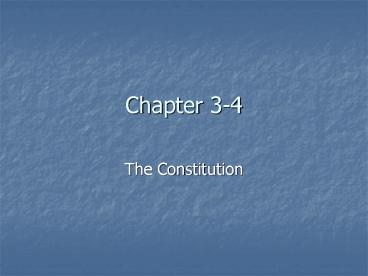The Constitution - PowerPoint PPT Presentation
1 / 26
Title: The Constitution
1
Chapter 3-4
- The Constitution
2
Outline of the Constitution (p. 758)
- Preamble
- Articles 1-7
- Article I legislative
- Article II Executive
- Article III Judicial
- Article IV Relations among the States
- Article V Provisions for Amendments
- Article VI Public Debts Supremacy of National
Law Oath - Article VII Ratification of Constitution
- Amendments
3
Basic Principles
- Popular Sovereignty
- Limited Government
- Separation of power
- Checks and Balances
- Judicial Review
- Federalism Shared Power
- National and State
4
Checks and Balances
5
Formal Amendment Process
- The Framers knew that even the wisest of
Constitution makers cannot build for all time.
Thus, the Constitution provides for its own
amendment that is, for changes in its written
words. - Four possible methods of Formal Amendments
changes or additions that become part of the
written language of the Constitution itself.
6
Formal Amendments Why is it Important?
7
Federalism and Popular Sovereignty
- The Amendment Process is a Federal and State
process. - Two steps shared between State and Federal
governments.
8
Proposed Amendments
- More than 10,000 joint resolutions calling for
amendments to the Constitution have been proposed
in Congress since 1789. - 33 Have been sent on to the States
- 27 Have been finally ratified
9
The E.R.A.
- The E.R.A. proposed by Congress in 1972 fell
three States short of ratification and died in
1982. - An amendment to give the District of Columbia
seats in Congress was proposed in 1972 it died
in 1985
10
The 27 Amendments
- The Bill of Rights First ten Amendments
- The Later Amendments
11
(No Transcript)
12
Informal Amendments
- The Passage of Basic Legislation
- Actions Taken by the President
- Key decisions by the Supreme Court
- Activities of Political Parties
- Custom
13
Chapter 4
- Federalism
14
Section 1 Objectives
- Define federalism and explain why the Framers
chose this system of government - Identify powers delegated to and denied to the
National Government, and powers reserved for and
denied to the States - Understand that the National Government holds
exclusive powers it also holds concurrent powers
with the States
15
Why Federalism??
- Strong yet provide and preserve strength to
States - Federalism defined
- Divided power between National Government and
State governments
16
Powers of the National Government
- The Expressed Powers Enumerated, written,
spelled out - Example Article 1, Section 8, Clause 1-17 (p.
764)
17
The Implied Powers
- Reasonably suggested, Necessary and Proper
Clause, Elastic Clause - Article 1, Section 8, Clause 18 (p. 765)
- To make all Laws which shall be necessary and
proper for carrying into Execution the foregoing
Powers and all other Powers vested by this
Constitution in the Government of the United
States, or in any Department of Officer thereof.
18
The Inherent Powers
- Powers inherent to all world governments
- Immigration
- Regulation of Foreign Trade
- Acquiring of Territory
19
Powers Denied to the National Government
- Powers to Levy duties on exports
- Powers to prohibit freedom of religion, speech,
or assembly - Conduct illegal searches or seizures
- Deny speedy and public trials
- Create public school system
- Marriage and divorce laws
- Congress cannot tax any States or local units of
government
20
Powers Reserved to the States
- Powers not granted to National Government, yet
not denied to the States. - 10th Amendment (p. 773)
- The powers not delegated to the United States by
the Constitution, nor prohibited by it to the
States, are reserved to the States respectively,
or to the people.
21
Powers Denied to the States
- No State can enter into any treaty, alliance, or
confederation. - No State can print or coin money
- No Sate can deprive any person of life, liberty,
or property without due process of law - No State can tax any of the agencies or functions
of the National Government - No State can violate its own State Constitution
22
The Exclusive and Concurrent Powers
23
The Federal System and Local Governments
- We have thousands of local governments yet
ultimately two forms States and National
24
The Supreme Law of the Land
- The Constitution , laws and treaties are the
supreme law of the land. Constitution stands
above all other forms of law. - Supremacy Clause
- Linchpin of the Constitution It joins the
National Government and the States into a single
government unit
25
The Division of Power Between the National
Government and the States
B
A
- Delegated powers of the National Government
- ?________
- ?________
- ?________
- Powers Denied the States
- ?________
C
F
E
D
26
Supreme Court and Federalism
- McCulluch vs. Maryland (p. 95)































